Christ's
Hospital School & other charity schools
A
riot of colours: Grey
Coat Boys, Blue Coat Girls,
Blue Coat Boys, Redsleeve
Boys and Greensleeve Girls schools... all Ipswich charity schools (not to mention Tooley's red and blue
colours)
Christ's
Hospital Buildings, 15 Wherstead Road
Ipswich was one of the first towns to adopt a compulsory poor rate to
finance the care of the 'indigent' poor who would formerly have been
cared for by the dissolved religious houses*. In 1568 it was decided to
build a poorhouse to complement the work of the Tooley Foundation; it
was named Christ's Hospital. Attached to this was a workhouse where
'vagrants and idlers' were put by the local beadle. 'Christ's Hospital
School' was run from some of those buildings. Tireless
documenter of Ipswich history, Simon Knott (see Simon's Suffolk
Churches on our Links
page) has discovered
the grave of the headmaster for 27 years of Christ's Hospital School,
William Platt Crossley: "In 1871 and 1881 he was
living with his wife Martha and
their children in the School House, Shire Hall Yard off of Foundation
Street in the middle of Ipswich, and his occupation was given as 'head
teacher, boys day school (endowed)'. Our Foundation
Street page shows the location of the school in School Street on a
1902 map. The school itself had moved to
grand new premises on Wherstead Road in 1841, but the coming of the
railway and the rise of dockside industry led to its closure and
demolition in the early 1880s. By 1891 the Crossley family had moved to
Tavern Street where William Platt Crossley now owned and ran a
tobacconist's shop. Shire Hall Yard remains as a street name between
Foundation Street and Lower Orwell Street."
[*The Dissolution of the
Monasteries, sometimes referred to as
the Suppression of the Monasteries, was the set of administrative and
legal processes between 1536 and 1541 by which Henry VIII (reigned 1509
until his death in 1547) disbanded
Roman Catholic monasteries, priories, convents and friaries in England,
Wales and
Ireland, appropriated their income, disposed of their assets, and
provided for their former members and functions. He was given the
authority to do this in England and Wales by the Act of Supremacy,
passed by Parliament in 1534, which made him Supreme Head of the Church
in England, thus separating England from Papal authority, and by the
First Suppression Act (1536) and the Second Suppression Act (1539).
Henry's young son, Edward VI, came to the throne in 1547 and, under
Thomas Cranmer's guidance, issued Injunctions for Religious Reforms in
the same year; in 1550, an Act of Parliament was passed 'for the
abolition and putting away of divers books and images', which continued
the Dissolution and introduced iconoclasm which removed or destroyed
'idolatrous' images.]
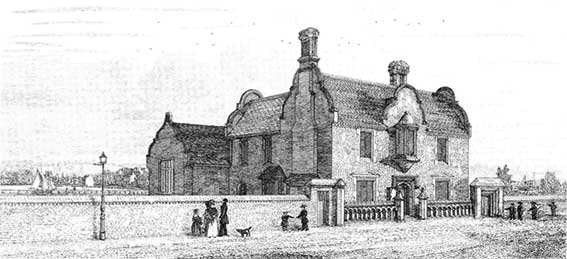 1843
1843
The above engraving, made by Henry Davey, is
dated 10 February 1843 and captioned: 'Christ's Hospital School,
Ipswich. Originally,
founded by charter of Queen Elizabeth, 16th May, 1572, it stood in the
Shire Hall Yard, St Mary-at-the-Quay,
and was removed to this spot in
1841 ... There is now accomodation for 40 boys who are educated,
boarded, lodged and clothed &c. from the funds of the charity.' In
August 1840 the charity trustees had appointed John Medland Clark,
designer of the 1844 Custom House, as
their architect to provide an improved Christ's Church Hospital School.
Eventually Chenery's Farmhouse in Great Whip Street was adapted for the
purpose. This despite plans drawn up by Clark to remodel the Friars'
Dormitory in Foundation Street (still used by the grammar school, but
in
poor condition) as
a new home for Christ's Hospital School.
See our 1867 map on the Felaw Street
page for the exact location
of the 'Blue Coat School' on Wherstead Road between the junctions
of today's Tyler and Purplett Streets.
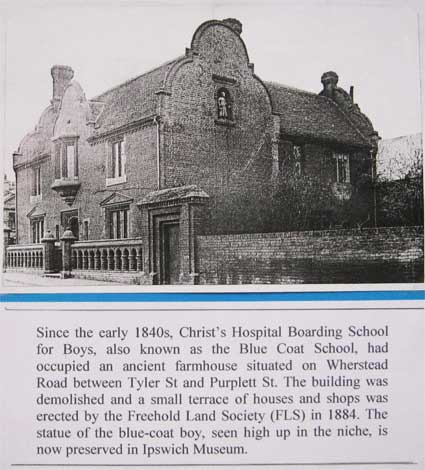
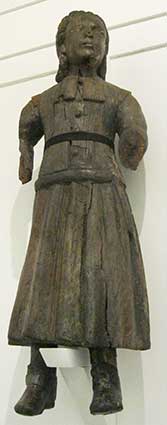 2018 image
2018 image
Above left: photograph
and caption by Over Stoke History Group. Above right:
the 150 year-old carved wooden figure of a Blue Coat boy which
decorated
Christ's Hospital School, as displayed in the You Are Here! The Making Of Ipswich
exhibition at the Art School Gallery in 2018.
There is indeed an 'FLS' (Ipswich &
Suffolk Freehold Land Society) plaque above numbers 13 the former
newsagent's
shop
and number 15 in
Wherstead Road which reads:
'CHRIST'S
HOSPITAL
BUILDINGS
F.L.S . 1884'
This stood near the site of
the school which was demolished in the 1880s and, given the former
Head's proprietorship of a Tavern Street tobacconist's mentioned by
Simon Knott,
perhaps the newsagent's shop
is appropriate.
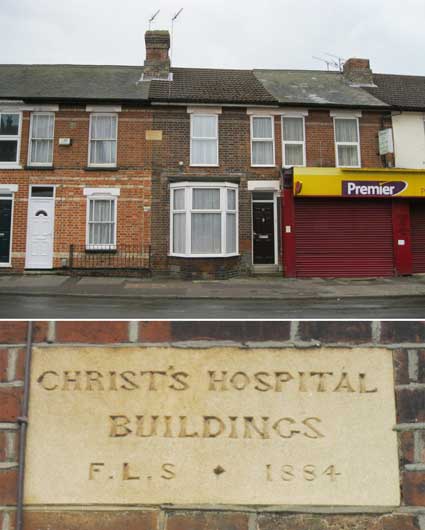 2013 images
2013 images
See our Felaw Street page for
the detail of White's 1867 map showing 'The Blue Coat School'
(Christ's Hospital) on Wherstead Road between the junctions of Purplett
Street and Tyler Street; so,
definitely on the site of
the terraced houses shown here.
Ruth Serjeant's research paper on the architect John
Medland Clark:
"The earliest building in Ipswich which can with certainty be
attributed to J.M. Clark is the Christ's
Hospital School, formerly at the junction of Wherstead Road and
Purplett Street. In a competition advertised by the Ipswich Charity
Trustees (27 Jun. 1840) he won the premium of ten guineas, against two
other entries, for the adaptation of the Chenery farmhouse on the site,
and was duly elected architect for the scheme (8 Aug. 1840). On its
completion it was reported that 'the transmutation of the unsightly
structure known as Chenery's Farm ... is as creditable to his talents
as an architect, as it is an ornament to that part of the town' (11
Sept. 1841). Henry Davy's etching of 1843 shows clearly why his plans
pleased the committee by their 'strict attention to the preservation of
the style of the original building ... the introduction of a wing .. .
and single storey to the rear ... and details of the exterior ...
gleaned from some of the many fine specimens of the same style in the
neighbourhood' (S.C., 8 Aug. 1840). The stepped round gables, the high
ornate chimneys and the simple symmetrical classicism of the facade
reflect in this one building at least two of the influences on
architectural styles, which, grouped together, became known as Early
Victorian. The Jacobean and Neo-Classical (of which we see elements
here) rubbed shoulders with the Elizabethan, the Neo-Gothic, the
Picturesque and the Baroque. The styles, and their influence on
architects throughout the Victorian era, were anything but static. The
main feature of Victorian architecture was the speed with which change
took place, with several fundamentally differing styles running
concurrently. Architects were freed from the restrictions and rigidity
of the rules and concepts of the classical 18th century, and enabled to
develop the freedom of choice, not only to vary style from building to
building, but also to combine one or more styles in the same building.
The acceptance of irregularity and the unexpected as worthwhile
principles in themselves, led to the growth of that eclecticism which
is the hallmark of Victorian architecture. Moreover, not only were
architects freed from the strict classical mould, but building
materials themselves, and their combination, both in texture
differences and colours, brought an exuberance to the architectural
result irrespective of the individual style of the particular building.
'Constructional polychromy' was the term generally applied to the
combination of different materials, while 'flat polychromy' was applied
to the use of the same material in different colours."
[Source: John
Medland Clark 1813-1849 'Sometime Architect of Ipswich' by Ruth
Serjeant, The Suffolk Institute of Archaeology and History reserch
paper. Volume XXXVII, part 3 (1991)]
Christ's Hospital School (1572-1881)
Henry Tooley, merchant, died in 1551 and left the bulk of his
considerable fortune to a charitable foundation whose main purpose was
to provide almshouses for ten ex-servicemen. They were to receive
clothes (a livery incorporating Tooley’s
red and blue colours), firewood and medical care together with
sixpence a week (more for those who couldn’t work), provided that they
attended morning and evening service at St
Mary-at-the-Quay. After disputes over the will delayed things for
eleven years, five almshouses were eventually built, each house either
to accommodate a married couple or two men sharing. They were probably
in the half acre orchard off Star Lane – then a much shorter, narrower
thoroughfare than today – which Tooley and his wife had leased from the
Blackfriars (dissolved by Henry III in 1538) in the 1530s. In order to
deal with rising poverty, the town acquired the Blackfriars premises
and set up Christ’s Hospital in the southern portion of its ample
buildings, the friars’ church having been demolished soon after
dissolution so that building materials and furnishings could be used
elsewhere. This is the church whose ruins are today still visible
between Lower Orwell Street and Foundation Street: the only visible
remnants of the five monastic establishments
in the town today.
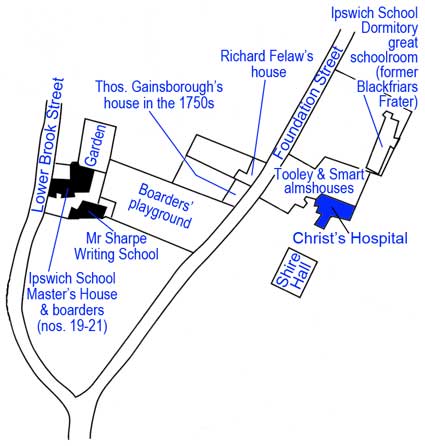 Early to
mid-19th century sketch map
Early to
mid-19th century sketch map
Below is the detail from Pennington's 1778 map
of this area, showing the school features. Note, just visible, the
legend 'Christ's Hospital' across the Tooley Almshouses. A row of
houses further down Foundation Street is labelled 'Tooley Foundation'
(just below the word 'Street').
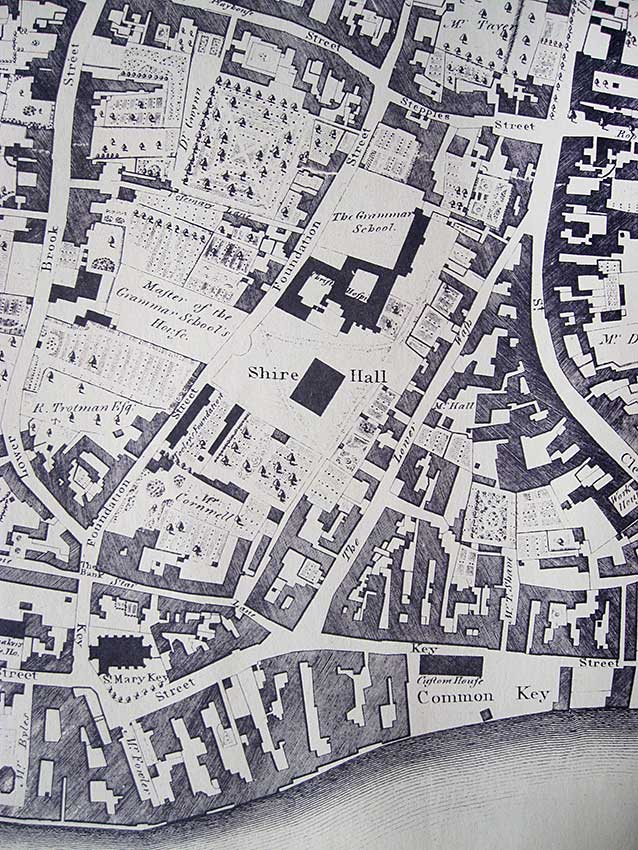 1778 map
1778 map
The name ‘Christ’s Hospital’ can be confusing, doubly so in that the
nearby Richard Felaw’s house and the Blackfriars Frater across
Foundation Street were occupied subsequently by the educational
establishment which was to become The Ipswich School (sometimes called
Ipswich Grammar School among other things). The above sketch map shows
the layout between Lower Brook Street and Foundation Street which had
slowly developed since the sixteenth century and led eventually to the
move of Ipswich School to the new Christopher Fleury-designed buildings
Henley Road in 1852 (see our Plaques page
for a photograph). “Hospital”: during
the Middle Ages hospitals served different functions to modern
institutions, being almshouses for the poor, hostels for pilgrims, or
hospital schools. The word hospital comes from the Latin hospes,
signifying a stranger or foreigner, hence a guest. Another noun derived
from this, hospitium, came to signify hospitality, that is the relation
between guest and shelterer. The Latin word then came to mean a
guest-chamber, guest's lodging, an inn. Hospes is thus the root for the
English words host (where the p was dropped for convenience of
pronunciation) hospitality, hospice, hostel and hotel. “Christ’s”: it
was not Christian, as such.
Christ’s Hospital in Ipswich has been described more as a workhouse for forty inmates,
both deserving and undeserving poor, both sexes and all ages. It was
also described as a ‘seminary of thieves’; vagrants were rounded up and
sent there as a punishment. Within a generation children predominated.
This was all funded by a poor rate of £170 per year, a penny or
tuppence a week from most of the 312 taxable householders; the richest,
Edmund Withypoll (at Christchurch Mansion) paid 16 pence. Half of this
amount went to Christ’s Hospital and half to ‘outdoor relief’ to, in
the 1570s, around eighty impoverished families in their own homes.
Oddly, actors, witches and rabbit-skin salesmen were specifically
excepted from this outdoor relief. By 1597 there were nearly twice as
many on such relief and extra funds were made available by Tooley’s
trustees who were also town officials.
An incomplete census of the poor for 1597 mentions 400 men, women and
children from nine parishes, 80% being in St Matthew’s and St Clement’s
in the suburbs and St Nicholas’ is in the town. The actual total,
including the three unrecorded parishes plus Christ’s Hospital and
Tooley’s and Daundy’s almshouses (the latter founded by Edmund Daundy
on Lady Lane) would have been nearer 600
this is comparable to the figure in 1297 at the time of the wedding of
Edward I’s daughter Princess Elizabeth (see King
Street) when, despite the many
intervening plagues, the population as a whole is likely to have been
smaller. By 1600 Christ’s Hospital and the almshouses of the Tooley
Foundation, though separately managed and set up with rather different
intentions, were moving towards an ever-closer union. The road running
beside the Blackfriars western wall soon acquired its present name of
Foundation Street.
Christ’s Hospital, some time after
the last of the Elizabethan Poor Laws in 1601, gave up its role as
the municipal workhouse and eventually became a school. The will made in 1670 by Nicholas Phillips, portman,
enabled the foundation of the school in Christ's Hospital, adding
education to the other provisions of Tooley’s and Smart’s Foundation, a
century after the 1572 Letters Patent had by implication required it.
It was not a grammar school because the blue coat boys there were never
more than about twenty in number, and at fourteen, they were usually
sent to sea as apprentices.
“[Grammar school headmaster] Leman’s troubles
began
when, in September 1605, the corporation ruled that Felaw’s house and
endowments were no longer to be used for the grammar school as had
surely been that benefactor’s intention. In fact, some of Felaw’s
endowments had been diverted since the re-foundation of the school
after Wolsey's College
failed. Ever since the charitable Christ's Hospital had been
established in 1572, it had been on the collective conscience of the
borough hierarchy that provision had still to be made there for
educating poor boys. Revising their view of Felaw’s intentions
retrospectively, the corporation would found a charity school, without
dipping into town finances or their own pockets. Grammar school places
were free to the sons of the town’s burgesses who entered as foundation
scholars, but that was not something which needed to be changed. Leman
was to leave Felaw’s House as soon as possible, finding another place
in which to teach his grammar pupils. Leman naturally protested but his
chances of winning the argument were doomed when a new and powerful
town preacher [Samuel Ward] was appointed at All Saints-tide (1
November) 1605.”
Apart from Christ’s Hospital, there were three other charity schools in
Ipswich at the beginning of the 18th century, all modestly endowed: the
Redsleeve School for boys at its Master’s house in Silent Street, and
the boys’ Grey Coat School
with its sister foundation the girls’ Blue
Coat School nearby. See Curriers Lane
for a plaque which once celebrated these schools. (Confusingly,
Christ’s Hospital pupils were known as Blue
Coat Boys.) In 1818 the three had a total of 156 children
between them. As at Christ’s Hospital, they were prepared for
apprenticeship, being taught practical skills in the morning with
reading – and sometimes writing – in the afternoon. Some of the boys
were apprenticed back to their fathers so they, at least, came from
reasonably prosperous homes. Subscribers supplemented the schools’
endowment income and £1 a year bought the right to nominate one pupil.
“Lists of those voting for each candidate in this hotly
contested [Ipswich School] mastership election were recorded by that
assiduous recorder
of Borough events Devereux Edgar, in his commonplace book. Edgar was a
prime mover in establishing another charity school in 1709 with high
church and Tory support based on the Tower Church: Grey Coat Boys and
Blue Coat Girls. Boys in blue coats belonging to Christ's Hospital
school. The low church Whig equivalent based on St Lawrence followed
eventually, for Redsleeve Boys
and Greensleeve Girls.
Supporters of the two schools insisted on the correct colours being
worn in the town so that they could judge behaviour.”
The newly-formed Charity Commissioners' new scheme for administration
of schools in 1881 meant that all the old borough charities were
combined and shared out between Ipswich School and the newly-formed
Northgate Middle Schools for boys and girls. When the Endowed School
governors were given control of the grammar
school and Christ’s Hospital in 1881 they therefore took over the
town’s
various educational charities which they amalgamated into 12 parts: 3
parts for a new girls’ secondary school, 4 for a new boys’ secondary
school and 5 for the grammar school. Christ’s Hospital was closed down after 300 years of
existence. (This would fit in with the F.L.S.
naming of the above building in 1884.) The girls got its junior school
in the southern half of the Blackfriars complex, and the boys its
larger house in the Wherstead Road, on the site of the old St Leonard’s
leper hospital. Soon both were moved to more modern accommodation.
[Sources: Bishop,
Peter: The history of Ipswich
and quotations from Blatchly, John: A
Famous Antient Seed-plot of Learning: A History of Ipswich School
(see Reading list)]
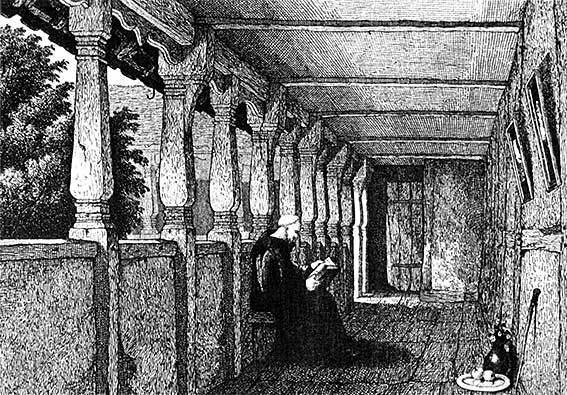 pre-1843
pre-1843
The upper cloisters, Christ’s Hospital (demolished
in 1843). The cloisters ran, with the exception of a
small space occupied by the cells of the Bridewell, along the four
sides of a grassy quadrangle and the upper galleries ran directly above
the lower ones for the same distance.
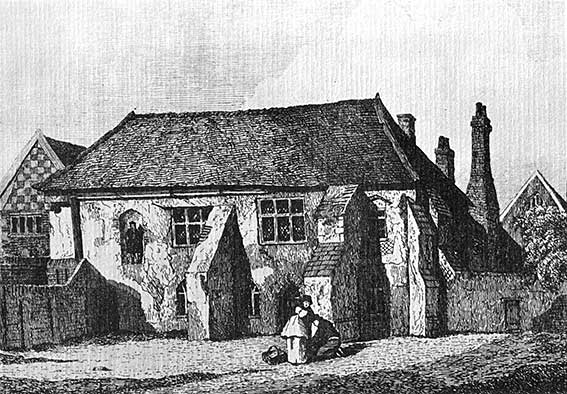 pre-1843
pre-1843
Christ’s Hospital (demolished
in 1843).
The Hospital once occupied a site at Shire Hall Yard in Foundation
Street and was founded by the Ipswich Corporation in the days of
Elizabeth I. Note the figure of the Blue Coat Boy in the niche at first
floor level. We wonder if that figure was carried across to the new
buildings in Wherstead Road (see the wooden figure above).
These engravings are from Frederick Russel
and Wat Hargreen's Picturesque
Antiquities of Ipswich (published in Ipswich, 1845).
[UPDATE
6.6.2020:
Nicholas Raphael got in touch from Sydney, Australia to say that his
third great
uncle – Alderman Abraham Raphael Jr attended the
Christ's Hospital School some time during the 1860s. For
Nic's full message, see our Old Jewish
Cemetery page.]
Charity schools in Ipswich
'In Ipswich the original benefactors were Tudor merchants Richard
Felaw, William Smart and Henry Tooley. Richard Felaw bestowed in his
will of 1482 his house ‘to be forever a common school house, or
dwelling house for the school master, together with other property, the
income from which would provide for the maintenance, not only of the
buildings but also of the running costs of the school’. Other notable
benefactors include William Smart, who with ‘The Great
Tooley of Ipswich’ (he must have been rich to gain a title
like that) left a legacy to create almshouses in Foundation Street (as
well as leaving money for the benefit of the grammar school). In the
17th Century Richard Martin left money for scholarships and William Tyler
left a similar legacy for the teaching and apprenticing of poor
children in the town.
In the 16th Century and the 17th Century there were very few schools.
The rich would pay a tutor to educate their sons, some would teach more
than one child and to these groups were added children of the poor,
supported by the benefactors like William Smart. By the 18th Century
these schools had become charitable institutions taking substantial
numbers of young children (but by no means all). They were not
universal, they taught to their own syllabus and were supported by
voluntary contributions, subscriptions and endowments. In Ipswich a
couple of these schools still exist, for example St Margaret’s was
originally the Red Sleeve School.
The Blue Coat Boy [public house] in the Old
Cattle Market was the site of the Blue
Coat School. The Grammar School had been established perhaps as
early as 1399 (by the end of the 15th Century there is hard evidence of
its existence). Its charter was obtained from Henry VIII and renewed
and improved by a further charter from Queen Elizabeth I.
When the Industrial Revolution took hold, the Wet Dock was enclosed (1844),
the
railway arrived (1846) and the urban population swelled. The
corporation began
to take a more significant role in educating the young but it wasn’t
until 1870 that compulsory education became universal, paid for by
collective taxation. The endowments which had been accumulating were
collected together and administered by the burghers of the town, 21
trustees appointed to supervise the collected municipal charities. By
1881 arrangements were in place to ensure that charitable contributions
supplemented, rather than replaced, public funding of state education.
Thus the Northgate Foundation was established, it has been through
numerous modifications and adjustments but its principles remain.
Changes at the turn of the 20th Century led to the acquisition of
school premises, the Girls’ School in School Street and the Boys’
School in Bolton Lane (see our More schools
page). School Street was alongside the Unicorn
brewery off Foundation Street, this school had previously been the
Boys’ School and before that Christ’s Hospital which at one stage was
also a beneficiary of the foundation. The site of the Girls’ School is
now the ruins of Blackfriars Monastery, a scheduled ancient monument
the foundations of which are preserved for the benefit of the town. The
Boys’ School eventually became the Music School [in Bolton Lane] and for a short time
the [public] library before being sold for conversion into apartments
Devereaux Court]. It is the
money raised from the sale of this property which provides the core
endowment for the foundation today.'
[Taken from John Norman's Ipswich
Icons column, Ipswich Star, 25 July
2016.]
Related pages:
For more on Wolsey and his ill-fated college (which, for about
two years, was also Ipswich Grammar school) see our Wolsey's College page.
Tooley's and Smart's Almshouses,
Ipswich Workhouses.
Home
Please email any comments
and contributions by clicking here.
Search Ipswich
Historic Lettering
©2004 Copyright
throughout the Ipswich
Historic Lettering site: Borin Van Loon
No reproduction of text or images without
express
written permission

 1843
1843
 2018 image
2018 image 2013 images
2013 images Early to
mid-19th century sketch map
Early to
mid-19th century sketch map 1778 map
1778 map pre-1843
pre-1843 pre-1843
pre-1843